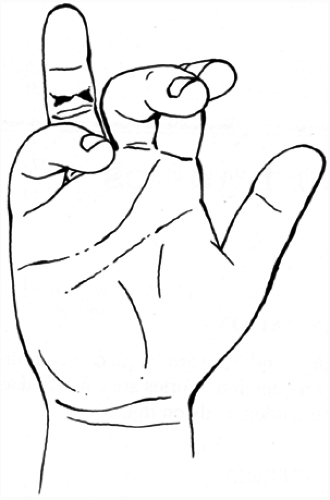Flexor Tendon Injuries
General Information
Lacerations to the palmar surface of the digit and hand are frequently complicated by injury to the flexor tendons. In general, tendon injuries are classified as partial lacerations, complete lacerations, and tendon avulsion injuries.
Diagnostic Criteria
History
Most patients present for evaluation of a laceration to the palmar surface of the hand that is associated with a loss of active digital flexion. Some patients with partial tendon injury may describe painful digital flexion. Depending on the location of the laceration there may be associated loss of digital sensibility and loss of motor strength. Inquire about tetanus immunization and other drug sensitivities should be determined. The position of the hand at the time of the injury (i.e., gripping a knife) may give some insight into the position of the distal tendon stump.
Less commonly, patients present for evaluation of a closed injury that is associated with loss of finger motion. These patients usually describe loss of distal interphalangeal joint motion following an injury. Patients with a closed tendon avulsion injury may also describe a painful nodule in the area of tendon retraction (usually the palm).
Physical Examination
Patients who have complete flexor tendon injuries will have loss of the normal “flexor cascade” (Fig. 1). Increasing the amount of wrist dorsiflexion will not increase the flexor tone in the fingers with complete tendon injuries. The integrity of tendon can be determined by asking the patient to flex each joint individually. Adjacent finger flexion and proximal joint flexion should be blocked. The location of the laceration(s), two-point discrimination, and capillary
refill should be determined. Allen’s test should be performed at the wrist on the digit (Chapter 4, Physical Examination of the Hand).
refill should be determined. Allen’s test should be performed at the wrist on the digit (Chapter 4, Physical Examination of the Hand).
Carefully palpating the flexor tendon sheath may elicit tenderness proximally at the site of tendon retraction. Patients with a flexor digitorum profundus avulsion injury often have a painful nodule in the palm, which represents the retracted tendon.
A PA and lateral radiograph should be performed when a fracture is suspected.
Palmar digital lacerations should be divided into four general categories based on the physical examination findings: simple lacerations, lacerations with associated tendon injuries, lacerations with associated tendon, nerve and vessel injuries and near amputations.
Stay updated, free articles. Join our Telegram channel

Full access? Get Clinical Tree








